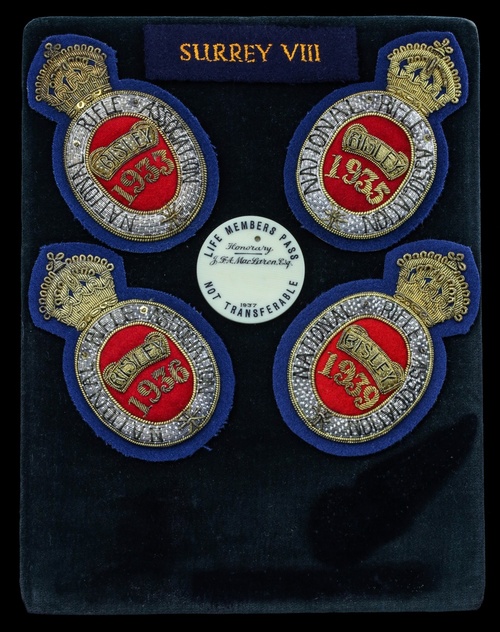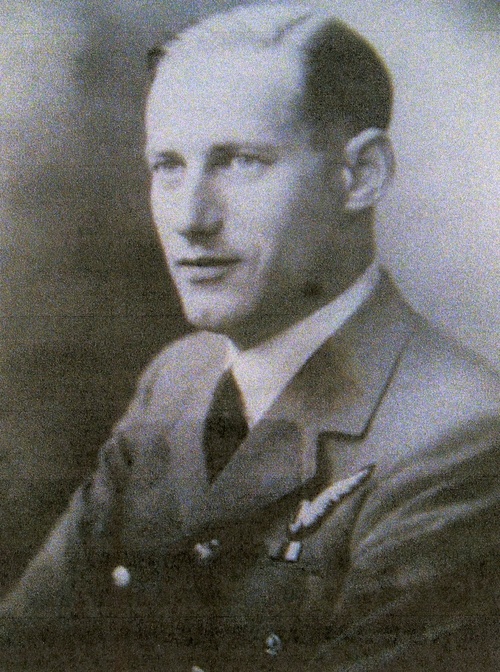Auction: 19003 - Orders, Decorations and Medals
Lot: 258
A fine group of three to ‘Strike Wing’ Beaufort and Mosquito Navigator, Flying Officer J. F. A. MacLaren, Royal Air Force Volunteer Reserve, who flew over 70 sorties with No. 143 Squadron, including numerous strikes on enemy E-Boats and shipping in the Channel and Bay of Biscay, followed by regular sweeps along the coastline of Norway; unfortunate not to have been decorated for his service, he nevertheless considered himself part of a ‘lucky’ crew, being one of just three men from his original cohort of 14 entrants to the Squadron who survived the war
1939-45 Star; Atlantic Star; War Medal 1939-45, unnamed as issued with paper packets of issue (2), in O.H.M.S. trasmission box addressed to ‘F/O J. F. A. Maclaren, 8 Chestnut Avenue, Southborough, Kent’, nearly extremely fine (3)
John Francis Arthur MacLaren was born on 31 December 1908 at Wallington, Surrey, the second child of William Leslie MacLaren who later became Managing Director of the Bank of Mauritius - now part of HSBC. He was educated at Temple Grove School in Eastbourne and was a contemporary of Douglas Bader, being photographed with the Headmaster and Bader as one of the 1922 ‘leavers’. Moving on to Repton School, Derbyshire, MacLaren began to foster an aptitude for shooting, becoming a member of the Shooting VIII in 1926. He also derived considerable enjoyment from the study of Classics, acknowledging that what he learned came in handy for solving crossword puzzles.
Having left school, MacLaren followed in his father’s footsteps and took employment with the Bank of England from 21 February 1927. Appointed Assistant in Feruary 1930, he spent much of the 1930s indulging a passion for small British sports cars and motorbikes, whilst also honing his marksmanship; in July 1935, he was ranked 65th/100 in a Rifle Club Competition staged at Bisley.
At the declaration of war, MacLaren moved with the Bank of England to Whitchurch where he continued to serve in a role exempt from national call-up. During the day he worked for the Bank and at night he served with the Hampshire Home Guard, being part of No. 5 Company of the 2nd Battalion, based at Whitchurch. Having conducted endless patrols and exercises, MacLaren decided that he could do more for the war effort and volunteered for the Royal Air Force Volunteer Reserve on 23 February 1942.
Passed by family repute as ‘too old’ for Pilot training, MacLaren swiftly elected to become a Wireless Operator and Air Gunner, being sent to No. 1 Signals School at Cranwell in August 1942. It was here that he faced a session in the ‘Harwell Box’ - the equivalent of a torture chamber in which the W/O. did his final ground training dressed in his full flying kit whilst trying to receive and transmit signals under the continuous roar of engines and chatter of machine-guns. Sometimes the box was swung around to achieve the feelings associated with air sickness; after 16 hours in this contraption, MacLaren graduated as a qualified W/O. on 14 September 1942.
He then travelled to Canada aboard the Queen Mary and conducted a Navigation Course at No. 33 Air Navigation School, Mount Hope, Hamilton. This was followed by further reconnaissance training on Anson and Beaufighter aircraft, the latter stages being paired up with Sergeant D. Brown - with whom he would fly until the end of the war. Promoted Sergeant himself, MacLaren returned home to England in the autumn of 1943 and was posted to No. 143 Squadron at R.A.F. St. Eval in Cornwall.
On 10 October 1943, MacLaren took off in a Beaufighter on his first operational sortie which involved acting as fighter protection. On the 24th he carried out a patrol in the Bay of Biscay, repeated on the 26th, before flying on 14 November 1943 in search of a landing craft. On Christmas Day 1943, MacLaren carried out an attempted shipping strike with 62 other aircraft, but no vessels were encountered and the aircraft returned to base. Further patrols continued in the Bay of Biscay, followed by a sweep along the Dutch coast on 29 February 1944. On 7 March his luck changed when he and Brown struck a convoy south of Borkum. According to his log book entry, ‘attacked armed Trawler; left it in smoke & flames.’ A strike on similar targets on 29 March 1943 noted, ‘attacked M.V. (1000 tons) & obtained hits. 1 Beaufighter missing.’
Rested for a few days prior to D-Day, MacLaren attacked ‘2 E/R boats with bombs’ on 8 June 1944, results not observed. He went on to conduct numerous armed recces, recording a ‘probable’ hit on a troop carrier on the 23rd and scoring a near miss against 5 E/R boats off the Hook of Holland on 26 June 1944. July witnessed similar attacks on E Boats moored in Boulogne harbour and regular patrols over Le Havre, whilst August saw further attacks on enemy shipping off Ostende and Dunkirk. On 1 September he attacked 5 E/R Boats off Westkapelle, his log noting ‘seriously damaged two, one with cannon.’ On 12 September he had a close shave when ‘chased by night fighters’, but his log goes on to note:
‘The return to base was ordered by the leader after a streak of light rising rapidly and vertically between clouds was assumed to be an enemy night fighter. It could, with more probability, have been an early V-2, launched from the Den Helder area.’
Posted to Banff soon thereafter, MacLaren’s attention switched to Norway and strikes on enemy shipping in the Fjords. Now flying in Mosquito aircraft, he attacked a warehouse at Stavanger on 28 December 1944; his log book at around this time being signed by Wing Commander Christoper Neil Foxley-Norris, later Air Chief Marshal of the Royal Air Force.
Having completed 71 low-level ‘Ops’ with No. 143 Squadron, MacLaren transferred to No. 9 Ferry Unit, later No. 36 Ferry Unit, in India. He was demobilised in January 1946 and returned home to his former job at the Bank of England, dying on 25 August 2002.
To be sold with the following original documentation, in addition to an impressive archive of copied research, including recollections from the recipient’s son:
(i)
Original R.A.F. Observer’s and Air Gunner’s Flying Log Book, detailing the recipient’s full period of service from 22 August 1942-January 1946, in good condition and well-annotated, together with medal compliment and entitlement slips, the latter marked, ‘178925 F/O’.
(ii)
Card R.A.F. dog tags, impressed ‘J.F.A. MacLaren, Offr C.E. 178925 R.A.F.V.R.’ (2); R.A.F. brass cap badge and crown; small silver R.A.F. ‘wings’ sweetheart brooch; contemporary embroidered Observer brevet; Home Guard Certificate of service; Home Guard fabric shoulder insignia and pin, with related Hampshire cap badge.
(iii)
An Honorary Life Membership Pass to J. F. A. McLaren, 1937, for Bisley; four impressive National Rifle Association badges, Bisley, dated 1933, 1935, 1936 and 1939, fabric and gilt wire, in good condition.
(iv)
Paperback copies of Coastal Command, The Air Ministry Account of the Part Played by Coastal Command in the Battle of the Seas, 1939-1942, and The Strike Wings, by R. C. Nesbit.
Subject to 20% VAT on Buyer’s Premium. For more information please view Terms and Conditions for Buyers.
Estimate
£400 to £500
Starting price
£280









